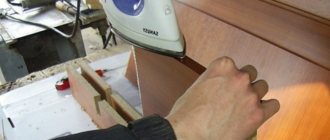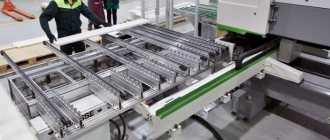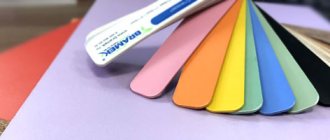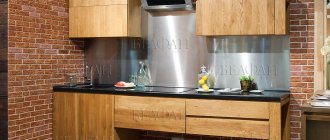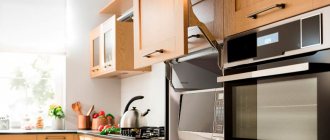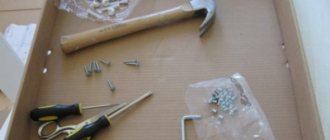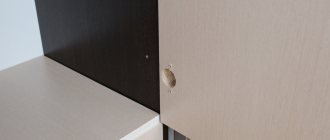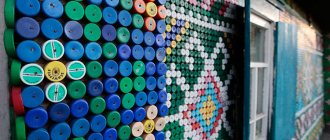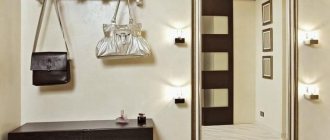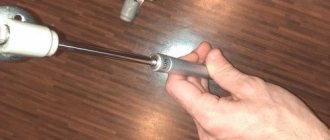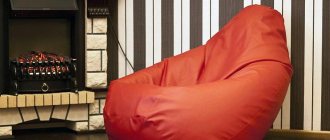Selection and use
When choosing edges, you should adhere to the basic requirements for them:
pay attention to the compatibility of the edging material and the furniture; for self-finishing, it is better to choose parts with an adhesive base; the type of fixation (mortise, overhead or rigid) is selected based on the purpose of the edge; the texture, color and coating of the products must match the characteristics of the furniture and improve its appearance.
Various types of edges are used for finishing MDF boards, chipboard and laminated chipboard, but are also widely used for decorating cabinets, chests of drawers, sets and walls, furniture lamps and cabinet furniture made by hand.
Choose only high-quality, durable types of cladding that match the interior, which can reliably protect the furniture and last as long as possible.
To learn how to properly glue furniture edges yourself, see the following video.
Plastic edge on chipboard: PVC and ABS
The main disadvantage of conventional melamine edging is its fragility. It performs well in use on the inner ends of furniture that are not subject to constant wear. On the visible ends (countertops, facades, open shelves) it wears out, chips, and takes on an unpresentable appearance. Another thing is the plastic edge for chipboard.
The most common two types: PVC edging (PVC) and ABS (ABS). Outwardly, they are practically indistinguishable, they are analogues, the differences are only in properties and composition. Both types are available in different widths and thicknesses of 0.4 mm, 1 mm and 2 mm, with and without adhesive base. An edge of 0.4 mm thickness or “one” is used on the internal boxes of furniture, and “two” on the table tops and facades.
PVC furniture edging is made on the basis of polyvinyl chloride, and ABS is made on the basis of acrylonitrile butadiene styrene. ABS edge is considered environmentally friendly because it does not contain chlorine or heavy metals and does not emit their harmful compounds when burned. Also, ABS as a material does not electrify, does not attract small debris and dust, exhibits less heat shrinkage when gluing and looks neater, smoother (without pressing) at the ends (if we are talking about a thickness of 0.4-1 mm). But it also costs more than PVC.
If you are interested in the process of gluing an edge to a chipboard, then it is much more complicated and requires additional skills and specialized equipment. In furniture production, plastic is edged on special edgebanding machines using high-temperature hot melt adhesives. There are manual edgebanding machines for small-scale production.
At home, gluing a PVC edge onto chipboard is possible, but it will take more time. Step by step:
It is important to very carefully prepare the end of the furniture piece for the sticker, especially if a thick edge, 1-2mm thick, is used. When a PVC or ABS edge adheres to the base, the glue can “pull out” the chips and the end will take on an untidy, lumpy appearance. If the PVC edge has an adhesive base, then it is heated with a construction hairdryer until the glue melts
If not, coat the end of the part with Moment glue and wait for it to dry a little for better adhesion. Then press the PVC (ABS) edging to the end (manually or roll it several times) and wait for the adhesive base to harden. Next, you need to carefully cut off the excess edges of the edging and sand it, giving it a uniformly rounded shape along the entire length of the part. Usually a milling cutter is used for these purposes. With some skill, you can get by with hand tools - a knife, a file and sanding paper.
What is PVC edge?
PVC edges are made from petroleum products and table salt. From the first they take ethylene. Salt requires chlorine, which, judging by the formula NaCl, contains exactly half of the substance. This half reacts with ethylene. The result is dichloroethane. It is converted into polyvinyl chloride by a two-step reaction.
Initially, PVC is a colorless and odorless powder. At the edge it is fused and painted. Any colors and patterns are possible. PVC edges for the body . The exception is heating from 100 degrees.
At high temperatures, hydrogen chloride is released. It depresses the respiratory system. Under normal conditions, PVC furniture edges protect against possible evaporation of the impregnation of laminated chipboards, MDF and chipboards.
This is what PVC looks like in its original form
Tables, cabinets, and sofas are made from them. Exposed edges of furniture sheets are not only potentially dangerous, but also unsightly. PVC tape completes the product, creating the illusion of solid wood rather than compressed sawdust.
Externally, the edge is made of polyvinyl chloride - a rolled material. Accordingly, it is elastic. Curvilinear surfaces can be processed. Ribbons of different widths, thicknesses, and colors are wound into coils. Lying on the ends of the furniture, the edge protects them from absorbing moisture and, as a result, swelling.
PVC does not allow water to pass through. The material is generally chemically resistant, resistant to acids, alkalis, alcohols and mineral oils. PVC swells only in aromatic hydrocarbons, for example, ethers and ketones. But in everyday life they are rare; they do not come into contact with furniture.
PVC edge
It differs from the first one in the material - PVC (polyvinyl chloride) is used instead of paper. Most often it is glued to the same hot-melt adhesive (on an industrial scale using special machines - edgers, but it can also be glued manually with ordinary liquid adhesives (for example, “Moment”). It is available in several variations in thickness - the most common are 2 mm and 0.4 mm ( There are also 0.8, 1, and 3 mm.) There are simply a huge number of decors, there are even glossy ones.
This edge is much stronger than the previous one; instead of chipping upon impact, it is only slightly pressed through.
The disadvantages include the laboriousness of gluing (if overhangs of 0.4 mm of the edge can be removed with a sharp knife, then 2 mm will have to be cut with a milling cutter, preferably with a specialized edge cutter (or on a machine), and not everyone has these devices).
Types of edges
The most popular types of furniture edges are:
- Melamine edge with glue is the most budget-friendly, but not the highest quality type. It is afraid of moisture and can fall off over time (even without mechanical impact), easily crack and wear off at the corners. The only plus is the pre-applied layer of adhesive, so melamine edging remains a popular option at home.
When purchasing furniture, it is important to pay attention to the quality of finishing of the ends. It is better not to buy furniture treated with melamine, as it will not last long.
- Furniture edging made of PVC 2 and 0.4 mm is the best option. It is much more stable and durable. A thickness of 0.4 mm is usually used to process hidden places, and 2 mm is glued to the outer ends that will be visible. However, its application requires a special edge processing machine, so it is used only in production.
- The edge made of ABS plastic is a more environmentally friendly analogue of the previous option, which is less common on sale.
- Mortise T-profile - inserted into a milled groove at the end of the chipboard. It was popular in those days when a special machine for PVC edges was rare, and there were plenty of milling machines in the shops.
Aluminum edging
The installation is similar to its plastic counterpart, but this material bends very poorly, so it has to be sawed, and even at an angle of strictly 45 degrees. For this, a simple miter box is not enough - you need a machine (and a milling cutter for a mortise edge), so it is practically not suitable for home craftsmen (I once sawed such an edge on a miter box - I suffered a lot, used up twice as much material as required, then finished it with a file, in short, I don't contact you anymore).
This material looks great, is not subject to abrasion and fading, and also increases the moisture resistance of laminated chipboard, but is difficult to install.
Profiles for processing furniture edges
You can trim the edge of furniture not only with edge tape. There are also furniture profiles that are attached mechanically. They are available in two sections - T-shaped or U-shaped (also called C-shaped).
For T-shaped furniture profiles, a groove is milled in the edge being processed. The profile is hammered into it with a furniture (rubber) mallet. The edges are cut at 45° to make the angle look attractive. It is brought to perfect condition with fine sandpaper. This type of profiles is produced from PVC and aluminum; with the same installation method, they look very different, and the differences are significant.
T-shaped furniture profile for processing furniture edges
In width they are available for laminated chipboards of 16 mm and 18 mm. There are also wide ones, but they are much less common, since they work less with such material.
C- or U-shaped profiles are most often mounted with glue. They coat the edge with it, then put on a plastic profile, press it well and fix it. These PVC profiles are soft and hard. Hard ones are harder to bend and it’s difficult to paste them over curved edges. But they have great strength.
Gluing C-shaped furniture profiles does not cause problems
If you still need to “fit” a rigid C-shaped furniture profile onto a bend, it is heated with a hair dryer, then given the desired shape and secured with masking tape until the glue dries.
Types of products by fastening method
The whole variety of edge protective and decorative products can be divided into two types based on the method of fastening to the furniture board - glued and non-glued. In the edges of the first group, the adhesive composition is not already applied to the tape or strip, and to attach them it is enough to attach a piece of the required length to the end of the part and heat it. In industry, special devices are used for heating; home craftsmen usually use an iron or hair dryer.
How to work with glue edges, all the important points are covered. We recommend reading our master class on using a hair dryer for edging.
On a note!
Fastening glueless products involves the use of a special adhesive composition, which requires special care, as well as compliance with technological installation requirements. Glueless ones include profiled plastic and aluminum decorative and protective strips.
Kinds
In modern furniture production, manufacturers offer several edging options. This is convenient for increasing or decreasing the cost of custom-made furniture. In addition, when making products yourself, the question arises of what type of furniture edge to choose. In order not to get confused, it is necessary to understand in detail the features of each, highlighting their pros and cons.
| Name | Description | Advantages | Flaws |
| Melamine | Sold in reels, attached only with glue. The edging tape can be single-layer or double-layer, and is made on the basis of paper. | There is a large selection of colors, the material easily follows the contours of the furniture, no additional equipment is required for the work - everything can be glued yourself. Melamine furniture edging is affordable. | Lack of protection against moisture, has a weak level of protection against mechanical damage. |
| PVC | Made from polyvinyl chloride. Available in two thicknesses, which are used for different parts of the furniture. The cost of the material is slightly more than its melamine counterpart. | The edge will provide protection from acids, alkalis and moisture. The assortment is represented by a rich color variety. PVC edges have a high level of protection against mechanical damage and are also considered durable. Another undoubted advantage is the non-flammability of raw materials. | The film is too rigid, which will not allow for quality processing of the product’s curves. In addition, it can only be fixed using a special machine. Self-attachment is excluded. |
| ABS | Manufacturing material: acrylonitrile butadiene styrene. This type is considered the most resistant to all types of damage. | The most durable edge of all presented. It does not contain chlorine, which is safe for human health. The ABS edge has a fade-resistant finish. It is soft and easy to cut, and does not emit toxic substances. | No significant disadvantages were found for this type of edge. The only thing that can stop you from choosing is the high cost, due to which the price of furniture will increase. However, this disadvantage is compensated by durability. |
| U-shaped from an overlay profile | The use of U-shaped furniture edges is used on products that are constantly exposed to moisture. | The special shape more reliably protects the ends from mechanical damage. The material can be fixed independently using glue. Additionally, it allows you to hide existing defects in the edges of furniture. Prevents any objects from sliding off the shelves or table. | Such framing is considered bulky and does not always look appropriate on furniture. |
Based on the information provided, we can conclude that ABS furniture edging is considered the most optimal for home use - it reliably protects the edges of products, preventing damage.
PVC
U-shaped
ABS
Melamine
Disadvantages of ABS Edge
The disadvantages of ABS edges include their high cost (compared to PVC, and especially melamine). In fact, ABS is used in different types of furniture, but it is especially relevant in the manufacture of truly high-quality products that must have increased performance properties, and especially when it is necessary to give the furniture an increased degree of resistance to humidity.
Dimensions
When choosing edging for furniture, it is important to take into account the size of the products - this will allow the interior items to look as natural as possible. Parts made of different materials have certain parameters
- The usual width of polyvinyl chloride products is 26.5 mm, but wider tapes from 150 to 300 mm are also found. Their thickness is 0.4, 1 and 2 mm.
- The width of the edge made of ABS plastic is 19-22 mm. The thickness of the finish is from 0.4 to 2 mm, but the most reliable protection is provided by a thick tape 3 mm thick.
- U-shaped overhead profiles are available in sizes 16x3 mm and 18x3 mm.
Before edging, it is worth measuring the thickness of various furniture items and parts. If chipboards are used - 16 mm, and when it is necessary to finish the tabletop - 32 mm.
Overlay and mortise edges
This type of edging is more decorative. It does not protect furniture parts from swelling and drying out, but only gives an attractive three-dimensional shape to the ends. It is used only for the design of visible ends - facades, cornices, countertops, open shelves, etc.
As is clear from the name, the overlay (U-shaped) and mortise edge does not require a sticker (in rare cases, only additional fixation, support), it is attached using protruding parts, wrapping around the end of the part or cutting into a specially prepared recess in the center of the end. They make flexible overlay and mortise edges from PVC and use them to decorate tabletops in office and student furniture.
The aluminum end, which frames the facades and countertops of kitchens, premium-segment office furniture, reception desks, etc., deserves special attention. Since the aluminum end is not able to go around corners, additional accessories are required for its installation - internal and external corners. Sometimes craftsmen do without them, sawing and joining the end at the desired angle.
ABS edge
It is made from Acrylonitrile butadiene styrene - to be honest, it is not much different from PVC edgebanding, the differences are more marketing ploys, but it is believed that such edgebanding does not fade in the sun, has more saturated colors, does not become electrified (which is convenient when milling - it does not stick to equipment), does not contain toxic impurities, and is simply stronger than PVC edge.
Naturally, such a wonderful thing costs a little more.
The standard sizes and work with it are similar to those with PVC edges.
Another option for processing the ends is edging stuffing. This technique is already a thing of the past, but nevertheless, it is still used due to its simplicity.
Advantages of ABS edge
The advantages of ABS edge include the fact that it:
- does not lose color qualities and is not subject to deformation;
- has a high-quality, rich, matte or glossy color;
- has a perfectly smooth surface;
- does not emit harmful substances;
- such an edge for chipboard is less dangerous when heated and processed than other materials.
We glue furniture edges with our own hands
There are two technologies for gluing furniture edge tape. The first is for those that have glue applied to the back. In this case, an iron or a hair dryer is needed. The second is for gluing tapes without glue. In this case, you need a good universal glue that can glue plastics and wood products and a furniture roller, a piece of felt or a soft rag so that you can press the edge well against the cut.
It’s possible to get such an edge at home
A little about what thickness of edge to glue on which parts. Those edges that are not visible, according to GOST, do not need to be glued at all, but basically they try to treat them so that less moisture is absorbed into the chipboard, and also to reduce the evaporation of formaldehyde. Melamine tape or 0.4 mm PVC is glued to these edges. The edges of the drawers (not the fronts) are also processed.
It is better to use 2 mm PVC on the front ends of the facade and drawers, and 1 mm PVC on the visible sections of the shelves. The color is chosen either to match the main surface or “in contrast”.
How to glue edging yourself with glue
The adhesive composition is applied to the melamine edge; it can be applied to PVC. If you choose PVC, it’s easier to start with thin ones - they are easier to process, any melamine is easy to glue.
We take an iron and a fluoroplastic nozzle on it. If there is no nozzle, thick cotton fabric will do - so as not to overheat the tape, but to melt the glue. A hair dryer is also suitable for this purpose. We set the iron to about “two”, while it is heating up we cut off a piece of tape. The length is a couple of centimeters longer than the workpiece.
Place the edge tape on the part
We apply the edge to the part, level it, smooth it out. There should be small pieces hanging off both sides. We take an iron and, using a nozzle or a rag, iron the edge, heating it until the glue melts. It is necessary to heat evenly over the entire surface. After the entire edge is glued, let it cool. Then we start processing the edges.
Warm up with an iron
The edge can be cut with a knife, both with the sharp and blunt sides. Some people use a regular metal ruler, while others find it more convenient to use a stainless steel spatula.
So, take the tool you have chosen and cut off the hanging edges of the edge. They are cut close to the material. Then cut off the excess along the part. Melamine and thin plastic are easily cut with a knife. If the PVC edge is thicker - 0.5-0.6 mm or more, difficulties may arise. Such edges can be processed with a hand router, if you have one. This guarantees good results in a short time. The processing will take longer if you use sandpaper, but the result may not be worse.
You can even use a spatula with a hard blade
One important point: when gluing thin edges, the cut of the part must be smooth, without protrusions and depressions. The material is plastic, which is why all defects are visible. Therefore, first go over the cuts with sandpaper, then thoroughly remove dust and degrease. Only after this can you glue.
Edging with PVC tape (no glue on the back side)
With this method of gluing PVC edges yourself, you need universal glue and a piece of felt or rag. We read the instructions for the glue and carry out all the steps as recommended. For example, for Moment glue, you need to apply the composition to the surface and distribute it, wait 15 minutes, and firmly press the surfaces to be glued.
Apply glue and wait - no problem. To press the edge tightly to the cut, you can use a wooden block wrapped in felt. Instead of a block, you can take a construction float and also attach felt to its sole. As a last resort, you can roll up thick fabric in several layers and press the tape to the surface.
Press firmly, leaning with all your weight
The selected tool is pressed against the laid edge, pressed with all its weight, pressing it to the surface of the chipboard. The movements are stroking. This is how they iron the entire edge, achieving a very tight fit. The part is left in this form for some time - so that the glue “seizes.” Then you can start processing the edges.
Types of PVC edges
buy PVC edges in different sizes. In width, for example, 16-32 mm options are popular. They are selected to the ends of furniture panels. The thickness of the edging itself also varies. This is an alternative name for PVC edgebanding.
PVC edge 2 mm – medium edge thickness option. The maximum is 4 millimeters, and the minimum is 0.4. The choice is determined by the load that the furniture has to withstand. The edges of tables, for example, require a thick and reliable edge; on shelves under the ceiling, a finish of 0.4 millimeters thick is justified.
Plays a role in the choice of PVC edge thickness and furniture style. Massive and deliberately rough implies a thick edging. Thin will come into stylistic conflict with the product.
The PVC edge on laminated chipboard differs in shape. In addition to straight ones, there are offers with rounded edges. They extend onto the planes of furniture panels. This eliminates gaps between the edge and the edge of the sheet in case of changes in its width.
Plus, the rounded edge of PVC for table tops, beds, cabinets, ensures streamlined joints. They are more difficult to damage and cause chipping. Over the years, the aesthetics of furniture with rounded edges has been preserved, while gaps appear at the ends with straight edges.
The colors of PVC edges are another reason for classification, and at the same time, distribution of products. In addition to imitating any type of wood, polyvinyl chloride adopts bright colors.
This is space for manufacturers of children's furniture. Making an “orange” sofa or a “Kiwi” chair from solid pine, for example, is problematic. Between an expensive solid wood product and the brightness of laminated plywood, the child will choose the latter. In addition, the high cost of natural furniture is useless in schools and kindergartens.
How to choose an edge for wardrobe parts and shelves
If you decide to make a wardrobe with your own hands, then you will have to deal with choosing an edge and determining the sides of the parts that need to be covered with an edge.
It happens when you can’t find an edge that matches the color perfectly. Then you have to choose something contrasting or matching in shade with the front fittings, profile, design of handles, lamps, mirrors of other furniture. It all depends on the overall design of the wardrobe and interior decoration as a whole.
Recommendations for choosing an edge and determining the sides for seaming:
- For different parts, different edge thicknesses and different types can be selected. For example, internal partitions and shelves can be covered with melamine edge or PVC 0.4 mm thick. The fronts of drawers are usually edged with PVC 1-2 mm thick. The visible ends of the sidewalls, bottom and visor can also be covered with PVC 1-2 mm thick or an overlay profile can be used.
- The sides of the wardrobe parts that will be adjacent to the front surfaces of other parts do not need to be glued with an edge. The same as the ends, which will be covered with a back wall made of fiberboard. If the cabinet is built-in and does not have a back wall, then it is better to process the ends adjacent to the walls, at least by gluing a melamine edge.
- Removable shelves must be pasted over the front edge. If you decide to edge them around the perimeter, then be sure to take into account the thickness of the edge. Even under the melamine edge, it is better to subtract 1-2mm from the width of the removable shelf so that it fits freely into the designated niche.
How to glue an edge with your own hands
At home, the easiest way is to glue the melamine edge with glue. To do this, you will need a hair dryer or iron, a piece of felt or rags for pressing the heated edge to the end, a stationery knife and fine sandpaper for cutting and sanding the edges.
How to glue melamine edge with your own hands
Step by step instructions for sticking melamine edge:
- The end of the chipboard is sanded and dust-free before applying the sticker. The melamine edge is thin and all the irregularities and protruding parts of the shavings will show through as untidy “bubbles”.
- The melamine edge is cut along the length of the end with a margin of several centimeters.
- Next, the edge is applied to the end with the adhesive side and pressed with a heated iron. The melting point of the glue is determined experimentally. You should not overheat the edge - the outer surface may turn white.
- If it is impossible to do this procedure with an iron (for example, with sharp corners in a part, radius places), use a hairdryer. Here you need to “work” with both hands at the same time - with one hold the hair dryer and heat the end with the edge, with the other - press the edge with a piece of felt or rags for uniform and tight gluing.
- After the edge has cooled, use a utility knife to carefully cut off the excess on the sides and sand it with sandpaper.
It is no less easy to “put on” an applied edging and a rigid profile on the ends of the partitions and shelves of a sliding wardrobe. This requires a mallet and your own strength.
Types of furniture edges
One of the most popular materials for making furniture is chipboard. Its disadvantage is the unsightly edges that remain when cutting the part. These edges are masked by the furniture edge. It is made from different materials, and accordingly, it has different properties and prices.
You can also get this edge yourself
Paper or melamine edges
The cheapest option is melamine-impregnated paper edges. The paper is taken of high density, impregnated with melamine to increase strength and glued to papyrus paper. Papyrus can be single-layer (cheaper) or double-layer. To prevent the melamine coating from wearing off, everything is covered with a layer of varnish. To make it more convenient to edge the parts, an adhesive composition is applied to the back side of the melamine furniture edge. When working, you just need to slightly warm up this composition and press it well against the end.
Paper or melamine edge is the cheapest, but also the most short-lived option for finishing the ends of furniture
The thickness of paper edge tapes is small - 0.2 mm and 0.4 mm are the most common. There is no point in making it thicker, and it will be expensive.
This type of edges is distinguished by the fact that it bends very well and does not break when bent. But its mechanical strength is very low - the edge quickly wears out. Therefore, if it is used, it is only on those surfaces that are not subject to load. For example, on the back of shelves, table tops, etc.
PVC
Polyvinyl chloride, which has recently become widespread, is also used in the production of edges for furniture. A ribbon of a certain width and thickness is formed from a mass painted in a certain color. Its front surface can be smooth, monochromatic, or it can be textured - with imitation of wood fibers. The number of colors is large, so it’s easy to choose the right one.
PVC furniture edging is the most popular material used by both home craftsmen and professionals. This is due to the relatively low price and good performance properties:
- High mechanical resistance.
- Withstands exposure to chemicals (household chemicals, for example).
- Waterproof material protects the ends of the product from moisture.
- PVC is an elastic material, which allows you to process curved surfaces.
- It can be processed well using simple tools, which allows you to get good results even at home.
PVC furniture edging is available in different thicknesses and widths. Thickness - from 0.4 mm to 4 mm, width from 19 mm to 54 mm. The thickness is chosen depending on the expected mechanical load or external appearance, and the width is slightly larger (at least 2-3 mm) than the thickness of the workpiece. There is a furniture PVC edge with an adhesive applied, and there is one without. Both can be glued at home (more on that below).
This type of edge material also has disadvantages: not a very wide temperature range: from -5°C to +45°C. For this reason, furniture cannot be left outside in winter, and when pasting with heat, you must be careful so as not to melt the polymer.
Made from ABS plastic
This polymer does not contain heavy metals and is characterized by high strength and durability. The disadvantage can be considered the high price, therefore it is used extremely rarely, although it has excellent properties:
- It is resistant to high and low temperatures, so when gluing you can use glue with any melting point. Small shrinkage when heated - about 0.3%.
- High mechanical stability.
This type of edge can be matte, glossy or semi-gloss. There are also options that imitate various types of wood. In general, this material is more convenient to use and more durable to use.
Veneer edge
Veneer is a thin section of wood, colored and shaped into a strip. This furniture edge is used in production for gluing sections of veneered products. Working with this material requires certain skills, and the material is expensive.
Veneer is not the most popular material for edging
Acrylic edge or 3D
Made from transparent acrylic. A design is applied to the reverse side of the strip. The layer of polymer on top gives it volume, which is why it is called a 3D edge. Used in the production of unusual furniture.
Acrylic gives the picture volume
Varieties
Edge materials are divided into several types according to the following parameters:
- manufacturing material - plastic, metal, paper;
- profile shape - U-shaped, T-shaped;
- width and thickness of the tape;
- gluing option - self-adhesive or regular surface.
The most common edging options are melamine, plastic and acrylic.
Plastic
Metal
Paper
U-shaped
T-shaped
Various in width and thickness
Self-adhesive
Regular
Melamine
Furniture edging is an inexpensive single-layer or multi-layer decorative finish on a paper base impregnated with melamine-formaldehyde resin. Both a self-adhesive version of the tape and one without an adhesive surface are produced. The former is easily applied to the end surface at home, while the latter is usually used in production shops where economy-class furniture is processed. A variety of colors allows you to choose your favorite option for any laminated chipboard (LDSP).
Updating the interior with recessed furniture lamps
Advantages of melamine protective tape:
- low cost;
- ease of application (both in production and at home);
- the pasting process does not require expensive equipment;
- wide range of colors.
The disadvantages of the product are considered to be:
- fine structure;
- low impact resistance;
- poor protection from humid air;
- fragility of the color image.
The melamine variety is made in various widths, which allows it to be used for a variety of furniture configurations, including for covering tabletops.
Plastic (ABS, PVC)
This edge material is distinguished by its impact resistance and resistance to temperature changes - from -30 to +100 ⁰С. Chlorine-free raw materials are easily recycled and are widely used in the domestic market and in EU countries.
Among the advantages of the material:
- does not emit compounds harmful to health;
- characterized by a beautiful smooth glossy or matte surface;
- Available in bright, rich colors;
- does not lose color over time and is not deformed;
- low toxicity when heated;
- resistant to aggressive chemical environments;
- when applied using a machine, it does not require low-temperature adhesive compositions, since it does not melt up to 100 ⁰C.
The disadvantages of ABS include its high cost compared to other types of edges.
Many consumers know what PVC (polyvinyl chloride) is. It is the most common plastic used in various industries. It is popular in the furniture industry. The composition is manufactured using a technological process called extrusion. The tape can withstand temperature fluctuations from -10 to +50 ⁰С. Available with a rich texture like wood, metal, plain, on a soft and hard base.
Pros of PVC material:
- high-quality impact protection;
- resistance to fire, moisture, chemical effects of acids, alkalis, salts;
- long service life;
- does not require special storage conditions;
- The price and quality are suitable for many consumers.
Users call the disadvantages of PVC tape:
- impossibility of extruding a smooth glossy strip;
- the need to purchase special glue with a low melting point to fix the edge to the chipboard.
In color design, plastic edges match many shades of chipboard.
Acrylic edge
A new generation of end tapes, in the manufacture of products, transparent plastic is used, called organic glass (PMMA), on the inside of which an image is applied - a 3D effect is obtained. The tapes are smooth and protect furniture well from impacts and exposure to aggressive environments. Used for chipboards located on the outside.
Purpose of furniture wax, advice on the correct use of the composition
The main advantages of the products include:
- strength;
- moisture resistance - can be used in the bathroom;
- resistance to aggressive environments - alkali, acid, ultraviolet radiation;
- resistance to temperature changes - from -35 to +85 ⁰С.
The disadvantages of acrylic include its high cost relative to other plastic edges. According to the shape of the profile, there are PVC edges of the U-shaped (overhead) and T-shaped (built-in) types. Products with an overlay profile are flexible and rigid. They are easier to stick at home. The disadvantage of this form is the protruding sides, near which dust and dirt accumulate over time.
The built-in profile is usually made of quite large thickness and hides the shortcomings of poor-quality cutting. It is considered reliable and durable, but requires a special groove at the end of the plate into which it is inserted.
Criterias of choice
Furniture edging significantly improves the appearance of cabinets, drawers, tables, and any other cabinet furniture. Today it is available in various colors, and choosing an option to match the shade of the furniture is not difficult.
To make the selection process easier, and the result to please the family for many years, pay attention to the following selection criteria:
Material – speaking of material, edgings can be divided into paper, plastic and rubber. The pros and cons of each of them have been described above.
When choosing, you should pay attention to its compatibility with the material of production of the furniture itself; Width - popular sizes vary between 22 and 38 mm, so before edging the product, it is worth choosing the optimal width - it should completely hide the edges of the product; Thickness – today manufacturers use edges from 0.2 mm thick. It is necessary to take into account the purpose and storage conditions of the furniture in order to select the required thickness parameter; Presence of an adhesive layer
This criterion is important for people who want to secure the edge to the product themselves. If the device does not have an adhesive layer, then you will not be able to make the edging yourself; Type of fastening - there are rigid, overhead and mortise edges. Depending on the purpose, choose one of the options. The mortise type is also divided into T-shaped and U-shaped; Surface type - edge coating can be glossy, matte, embossed or embossed. Take this criterion into account to improve the appearance of the furniture.
Having studied all the indicators of furniture edges, you can safely go for a new set of furniture
When purchasing, pay special attention to the quality of processing of the edges and end parts. It is worth additionally asking the seller about the method of fixing the edge
By purchasing furniture products with durable edges, you can ensure they have a long service life.
Scope of use
Regardless of what type of edge is used, it is designed to protect the end parts of the product. Such a device is especially necessary when producing inexpensive furniture from chipboard or laminated chipboard. Since these materials contain harmful formaldehydes, which over time can evaporate their substances into the atmosphere. Edge materials allow you to cover raw edges, preventing the spread of fumes.
Independent production of furniture parts implies the mandatory use of edging. If this is not done, then during operation the uncovered edges of the product will be subject to rapid wear.
Possible causes include accidentally touching the edge, scratching with a sharp object, or carelessly closing the doors. This is why processing chipboard with edge material is so important in furniture production
To consolidate the information provided, it is necessary to highlight a number of functions performed by the edge - a special tape made from various raw materials for processing the edges of furniture:
- Beautiful appearance of the ends of the products. When shopping in a store, the buyer first of all looks at the aesthetic design. It is unlikely that he will want to install a sliding wardrobe where the internal shelves look unfinished, and their edges differ in color and structure from the facades;
- Protection from mechanical damage. Edge materials are designed to protect fragile chipboards from moisture and delamination. Chips and burrs caused by impacts can cause snags on clothing and scratches on the skin. The laminated surface of furniture can crack even when in contact with a hard object. If the edges of the parts are sealed with edging, the degree of damage and the chances of loss of attractiveness of the models are minimal;
- Protecting human health. As already mentioned, the edge plays an important role in maintaining the health of household members. The longer the furniture is used, the higher the risk of formaldehyde resins escaping from the chipboard.
When choosing products for your home, you should pay attention to these subtleties. They will help maintain the attractiveness of furniture and extend its safe use.
Why do you need an edge?
Self-adhesive furniture edge - a narrow strip of melamine, polyvinyl chloride, ABS plastic or other material. It protects and decorates the cut area. When producing cheap furniture from laminated chipboard, edging is simply necessary, as it protects people from exposure to harmful formaldehyde. In addition, it gives strength and protects the material from moisture getting inside.
